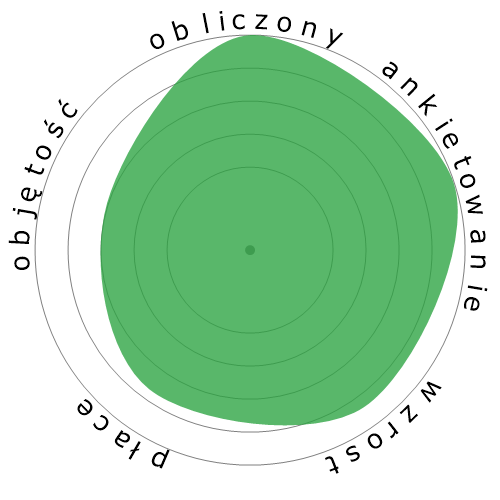Fizjoterapeuci




Ludzie również oglądali
Obliczone ryzyko automatyzacji
Minimalne ryzyko (0-20%): Zawody w tej kategorii mają niskie prawdopodobieństwo automatyzacji, ponieważ zazwyczaj wymagają one skomplikowanego rozwiązywania problemów, kreatywności, silnych umiejętności interpersonalnych oraz wysokiej sprawności manualnej. Te prace często wiążą się z złożonymi ruchami rąk i precyzyjną koordynacją, co utrudnia maszynom naśladowanie wymaganych zadań.
Więcej informacji na temat tego, czym jest ten wynik i jak jest obliczany, jest dostępne tutaj.
Ankieta użytkownika
Nasi goście zagłosowali, że jest małe prawdopodobieństwo, iż ten zawód zostanie zautomatyzowany. To ocena jest dodatkowo wspierana przez obliczony poziom ryzyka automatyzacji, który szacuje 0,0% szansę na automatyzację.
Jakie są Twoje zdanie na temat ryzyka automatyzacji?
Jakie jest prawdopodobieństwo, że Fizjoterapeuci zostanie zastąpione przez roboty lub sztuczną inteligencję w ciągu najbliższych 20 lat?
Nastroje
Poniższy wykres jest zamieszczany wszędzie tam, gdzie istnieje znaczna liczba głosów, aby przedstawić istotne dane. Te wizualne reprezentacje pokazują wyniki ankiet użytkowników w czasie, dostarczając istotnych wskazówek dotyczących trendów nastrojów.
Nastroje w czasie (rocznie)
Wzrost
Liczba ofert pracy na stanowisku 'Physical Therapists' ma wzrosnąć 14,2% do 2033
Całkowite zatrudnienie oraz szacowane oferty pracy
Zaktualizowane prognozy mają być dostępne 09-2025.
Płace
W 2023, mediana rocznej pensji dla 'Physical Therapists' wynosiła 99 710 $, czyli 47 $ za godzinę.
'Physical Therapists' otrzymali wynagrodzenie wyższe o 107,5% od średniej krajowej, która wynosiła 48 060 $
Płace z biegiem czasu
Objętość
Od 2023 roku zatrudnionych było 240 820 osób na stanowisku 'Physical Therapists' w Stanach Zjednoczonych.
To oznacza około 0,16% zatrudnionej siły roboczej w całym kraju.
Inaczej mówiąc, około 1 na 630 osób jest zatrudnionych jako 'Physical Therapists'.
Opis stanowiska pracy
Oceniaj, planuj, organizuj i uczestnicz w programach rehabilitacyjnych, które poprawiają mobilność, łagodzą ból, zwiększają siłę i poprawiają lub korygują warunki uniemożliwiające funkcjonowanie wynikające z choroby lub urazu.
SOC Code: 29-1123.00


Komentarze
Leave a comment
Big issue is one of liability. When the Pt does something incorrectly, or gets hurt doing something, who becomes liable?
Not possible in next 30 years.
The data you say will help us only.
Long answer - while I agree with the previous commenters that 'Someone needs to be there', who is that someone? Is it just a PT Assistant and a chatbot that comes up with the plans and the assistant guides the exercises? You need to consider reduction in job scale (thus salary) here not just elimination.
I say no overall because the way I think about it is people will pay for this service (mainly the care/psychological aspect and not just the exercises that they could find on google already). I have been in this situation myself. This isn't a fast food restaurant where people just want their food and don't care how it is made. I think if the therapist is good at the care, patient management, psychology, and any additional 'experience' aspects in addition to knowing the technical stuff they will be fine.
I am a physical therapist. We don't treat injuries based solely on reported impairments. We view each injury holistically. If AI can treat chronic pain patients better than us therapists, then that would be a nice day.
Plus, would you rather have a robot treating and instructing you to exercise? I don't think so. Physical therapists also face patients who are in their worst state. Imagine being treated by robots like Darth Vader. Yes, that might sound profitable for some hospitals, but ask any patient if they would like to be handled solely by robots.
We're not just patting your backs or asking you to lift some weights. We see you as more than just your back problem. We don't just zap or pat your backs.
Furthermore, in most health problems that physios treats, exercise is the most recommended intervention. And many exercises can be done without a professional supervision. This scenario could allow a patient to download an app that facilitates to conduct a self treatment.
If all physiotherapy was, was prescribing exercises, then it would definitely have a huge chance of being replaced by automation soon. Look at the field of radiology for a good example of this phenomenon—technology is getting exceedingly good at finding and diagnosing illnesses without human help. But the work physios do is diverse. Yes, prescribing exercises is a part of the job, but hands-on manual therapy is just as important. The variety of work within the field of physiotherapy is enormous as well. Physios may specialise in everything from working with athletes to patients with neurological disorders.
Physiotherapists undergo training in tangential fields, such as psychology, in order to be better able to understand their clients. After all, the goal is really to help patients in the best possible manner! Great physios also act as psychologists, guiding their patients through the mental challenges of rehabilitation and overcoming injury or illness (which may take place over the course of several months). Just like in occupational therapy (physiotherapy's sister), human-to-human interaction is a huge part of the job. This isn't something that can be replaced by a robot, at least not easily...
You never know fifty, one hundred years down the line. Just look at the difference between 2020 and 1970, 2020 and 1920. Honestly though, physiotherapy is absolutely safe considering the current situation of technological development. It will be one of the fastest growing, in-demand occupations in the next few decades.
Zostaw odpowiedź na temat tego zawodu